Home | Tours | Trip Reports | News | Team | Calendar | Links | Contact | Store | Mailing List
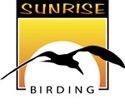
The Stunning Southeast!
October 22 - November 1, 2026
Contact
gina@sunrisebirding.com to reserve
your space!
Trip
Cost & Travel
Planning> Registration
Form>
Tour
Registration, Terms,
Cancellation Policies>
COMBINE THIS TOUR WITH TASMANIA
November 1 - 10, 2026 -- INFO & RESERVATIONS>
Southeast Australia is known for its stunning coastlines, diverse landscapes including outback regions and unique birds found only here. Our 11-day tour takes in the best birding areas that the south-eastern corner of mainland Australia has to offer. From cool temperate rainforests to coastal salt marsh, mallee heaths and outback plains, we marvel at wide variety of birds within, as well as a good number of mammals and reptiles.
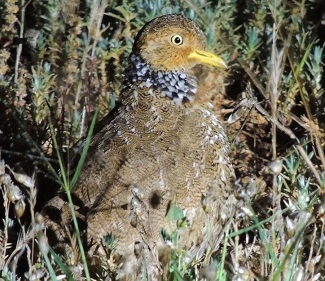 We begin our tour in Melbourne exploring the shorelines and swamps of western Port Phillip Bay. The Great Ocean Road will give us access to heathlands, forest, shoreline and estuaries of the region. Then we make our way toward the drier woodlands of central Victoria and its box-ironbark woodlands and mallee heath vegetation communities offering bird species that are typical of the mallee regions. From here we head further north and to the open plains on very edge of the outback to search for the enigmatic Plains Wanderer and other specialty birds of the region. We'll also seek out the amazing Superb Lyrebird and more unique nocturnal mammals near Healesville. We finish back in Melbourne where those wanting more adventure can continue to Tasmania.
We begin our tour in Melbourne exploring the shorelines and swamps of western Port Phillip Bay. The Great Ocean Road will give us access to heathlands, forest, shoreline and estuaries of the region. Then we make our way toward the drier woodlands of central Victoria and its box-ironbark woodlands and mallee heath vegetation communities offering bird species that are typical of the mallee regions. From here we head further north and to the open plains on very edge of the outback to search for the enigmatic Plains Wanderer and other specialty birds of the region. We'll also seek out the amazing Superb Lyrebird and more unique nocturnal mammals near Healesville. We finish back in Melbourne where those wanting more adventure can continue to Tasmania.
Join us for an exciting birding adventure in southeast Australia!
Contact gina@sunrisebirding.com to reserve your space!
Photos: Top, Gang-gang Cockatoo by Pat Kelly; Plains Wanderer by Edward Door.
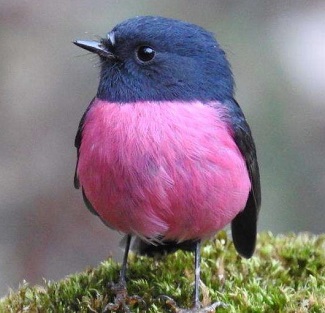 ITINERARY
ITINERARY
Day 1. Arrive Melbourne, Australia
Arrive in Melbourne and check into your hotel. Meet your fellow guests and your guide for dinner at the hotel to get to know each other and discuss the plans for the upcoming tour. Accommodation: Melbourne Hotel (en suite rooms). Meals included: D.
Day 2. Melbourne to Lorne.
This morning we will head to the south-west of Melbourne and wind our way through the shorelines and various swamps of western Port Phillip Bay, where we’ll aim to pick up a few wetland and grassland birds like Sharp-tailed, Curlew and Marsh Sandpipers, Red-necked Stint, Red-kneed Dotterel, Black-fronted Dotterel, Red-capped Plover, Pacific Gull, Hoary-headed Grebe, Australasian Gannet, Pied, Little Pied, Great & Little Black Cormorants, Australian Pelican, Crested, Fairy & Whiskered Terns, Australian Shelduck, Red-necked Avocet, Banded & Pied Stilts, Royal & Yellow-billed Spoonbills, White-fronted Chat, Striated Fieldwren, Horsfield’s Bushlark, Brown Songlark, Australian Pipit, Yellow-rumped Thornbill, Golden-headed Cisticola, Zebra Finch, Swamp Harrier, Wedge-tailed Eagle, White-bellied Sea-eagle and Black, Brown and Peregrine Falcons.
Accommodation: Geelong (en suite rooms). Meals included: B, L, D.
Photos: Above, Pink Robin by Cat Davidson; Below, Satin Flycatcher by Dennis Braddy.
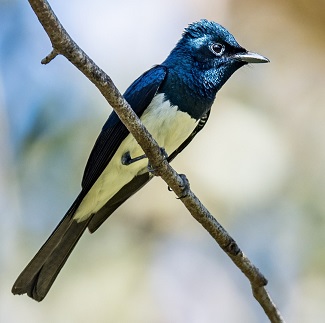
Day 3. Great Ocean Road area.
We will explore the Great Ocean Road today and visit the heathlands, forest, shoreline and estuaries of the region. Birds to be found throughout this area include Rufous Bristlebird, Hooded Plover, Southern Emu-wren, Brush Bronzewing, Satin Flycatcher, Yellow-tailed Black- cockatoo, Forest Raven, Olive Whistler, Grey Goshawk (white phase), Bassian Thrush, Satin Bowerbird, Crescent, Singing & Spiny-cheeked Honeyeaters, Eastern Spinebill, Rose & Scarlet Robins, Red-browed Finch, Chestnut-rumped Heathwren, Striated Fieldwren, Mistletoebird, Olive-backed Oriole, Gang-gang Cockatoo, Australian King-Parrot, Blue-winged Parrot, Shining Bronze-cuckoo, Grey Shrike-thrush, Striated Thornbill, White-browed Scrubwren, Sacred Kingfisher, Laughing Kookaburra, Spotted & Striated Pardalotes, Sooty Oystercatcher, Black- browed, White-capped & Yellow-nosed Albatrosses, Fluttering Shearwater, Black-faced Cormorant, Pacific & Kelp Gulls and Great Crested Tern. Mammals include Koala, Eastern Grey Kangaroo, Swamp Wallaby and Common Wombat. Accommodation: Geelong (en suite rooms). Meals included: B, L, D.
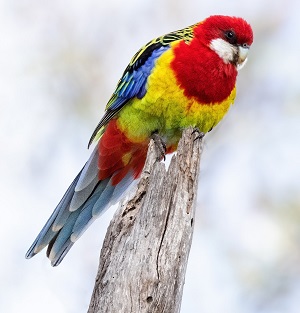 Days 4 & 5. Inland woodlands, mallee and heath
Days 4 & 5. Inland woodlands, mallee and heath
Lorne to Bendigo. Moving north today, we will make our way towards the drier woodlands of central Victoria. Here predominately box-ironbark woodlands and mallee heath vegetation communities harbor a number of bird species that are not found closer to Melbourne and are typical of the mallee regions in the far north-west of the state. Birds to expect here include Crested Bellbird, Gilbert’s Whistler, Shy Heathwren, Purple-backed Fairy-Wren, Yellow-plumed, Tawny-crowned, Purple-gaped, Blue-faced, Singing, Yellow-tufted, Fuscous, Black-chinned, White-plumed, White-eared & White-fronted Honeyeaters, Brush & Common Bronzewing, Noisy Friarbird, Chestnut-rumped, Yellow, Buff-rumped & Inland Thornbills, Western Gerygone, Hooded, Scarlet & Red-capped Robins, Rainbow Bee-eater, Dusky, White-browed & Masked Woodswallows, Purple-crowned, Little & Musk Lorikeets, White-bellied Cuckoo-Shrike, Black- eared, Horsfield’s Bronze & Pallid Cuckoos, Red-rumped Parrot and Eastern Rosella (Photo: Keith Kennedy). Also possible are Leaden & Restless Flycatchers, Speckled Warbler, Weebill, White-browed Babbler, Brown Treecreeper, Long-billed Corella, Brown Goshawk, Wedge-tailed & Little Eagles, Australian Hobby, Australian Raven, Jacky Winter, White-winged Chough, Rufous Songlark, Tree Martin & Diamond Firetail.
Accommodation: Hotel in Bendigo (en suite rooms) for 2 nights. Meals included: B, L, D both days.
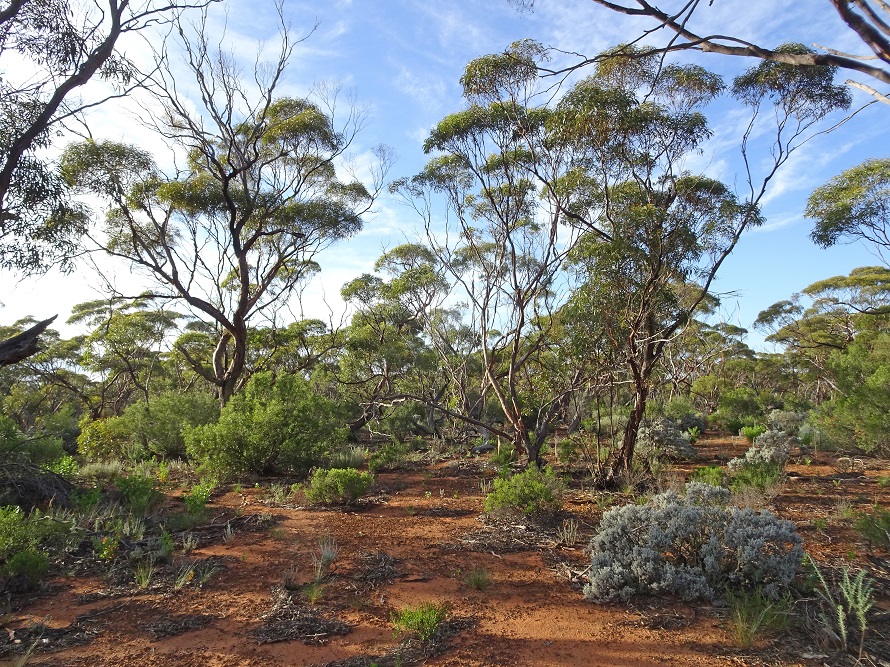
Photo: Mallee Country by Jenny Thynne
 Day 6 & 7. Plains Wanderer and other specialties:
Day 6 & 7. Plains Wanderer and other specialties:
Bendigo to Deniliquin.
We will have another morning in some mallee habitats to clean up a few birds we may have missed before heading further north and to the open plains on very edge of the outback. The district supports a huge range of birds including White-backed Swallow, Black Falcon, Orange Chat, Painted Honeyeater, Wedge-tailed Eagle, Greater Blue Bonnet, Southern Whiteface, Apostlebird, Grey-crowned Babbler, Striped Honeyeater, Superb Parrot, Australasian Bushlark, Brown Songlark and Spotted Harrier, and we will endeavor to catch up with most of these whilst in the area. With local guide and legend Philip Maher at the helm for our first evening, the main target after dark will be the enigmatic Plains Wanderer (Photo: Edward Door) and depending on local conditions and/or how much rain has fallen in recent times there may be the chance of other specials like Australian Pratincole, Inland Dotterel, Stubble Quail and Banded Lapwing.
Nocturnal birds feature as well, and we could pick up Barn Owl (Photo: Steve Bird), Southern Boobook, Australian Owlet-nightjar and Tawny Frogmouth. Mammals here range from the mighty Red Kangaroo, Western Grey Kangaroo, Common Brushtail Possum and tiny Fat-tailed Dunnart.
Accommodation: Deniliquin (en suite rooms) for 2 nights. Meals included: B, L, D both days.
Day 8. Red Gum Forest and Riverina: Deniliquin to Seymour.
Today we will have a more relaxed departure after what will probably be a late night the previous evening, and so with a bit of travel day birding will be limited as we head south back into Victoria. Along the way we will have a look at some of the wetlands in the red gum forests of the Riverina and hope to connect with the rare Square-tailed Kite, Australasian Bittern and Black-backed Bittern, plus another chance of Superb Parrot. Further south we will stop at some heathy woodland and look for Spotted Quail-thrush, Chestnut-rumped Heathwren, Scarlet Robin, Speckled Warbler and Leaden Flycatcher.
Accommodation: Beechworth (en suite rooms). Meals included: B, L, D.
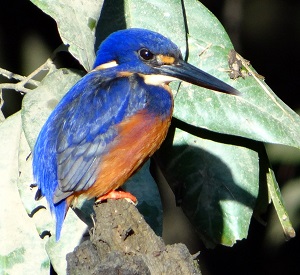 Day 9. Into the tall wet Eucalyptus forests: Seymour to Healesville.
Day 9. Into the tall wet Eucalyptus forests: Seymour to Healesville.
Today we will head toward the ranges east of Melbourne and slightly higher altitudes where the habitat changes into tall mountain forests and dense fern gullies. En route we will explore some open woodland habitats, with the possibility of some harder to track birds like Azure Kingfisher (Photo: Gina Nichol), White-throated Gerygone, Weebill, Buff-rumped Thornbill and Dollarbird.
Accommodation: Healesville (en suite rooms). Meals included: B, L, D.
Day 10. Superb Lyrebird & amazing nocturnal mammals: Healesville.
Birds we can expect to see include the amazing Superb Lyrebird, as well as Eastern Whipbird, Black-faced Monarch, Pilotbird, Red-browed & White-throated Treecreepers, Pink, Rose, Flame & Eastern Yellow Robins, Large-billed Scrubwren, White-throated Needletail, Rufous Fantail, Varied Sittella, Rufous Whistler, Cicadabird, Black-faced Cuckoo-shrike, Crested Shrike-tit, Crimson Rosella, Brown Gerygone, Satin Flycatcher, Fan-tailed & Brush Cuckoos, Shining Bronze-cuckoo and Olive Whistler. Tonight, we can try for nocturnal birds like Sooty Owl, Southern Boobook and Tawny Frogmouth. Nocturnal mammals include the possibility of Greater Glider, Yellow-bellied Glider, Sugar Glider, Mountain Brushtail Possum and Common Ringtail Possum.
Accommodation: Healesville (en suite rooms) as for last night. Meals included: B, L, D.
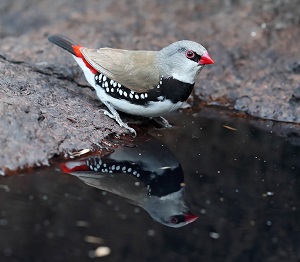
Day 11. Healesville to Melbourne.
This morning we will check a few areas in the forest for any birds we might still be missing, before making our way back towards Melbourne. Along the way we can stop at a colony of Bell Miner, as well as a known site for day-roosting Powerful Owls. Nearby we will visit a huge encampment of Grey-headed Flying Foxes. We will arrive back in Melbourne in the late afternoon for flights out or to join the TASMANIA tour> Meals included: B, L, D
Photo, left: Diamond Firetail by Chris Tzaros.
Photo credits (top to bottom): Gang-gang Cockatoo by Pat Kelly; Plains Wanderer by Edward Dorr; Pink Robin by Cat Davidson; Satin Flycatcher by Dennis Braddy; Mallee Country by Jenny Thynne; Plains Wanderer by Edward Dorr; Barn Owl by Steve Bird; Azure Kingfisher by Gina Nichol; Diamond Firetail by Chris Tzaros; Blue-winged Parrot by Dennis Braddy; Red-rumped Parrot by Cindy Marple.
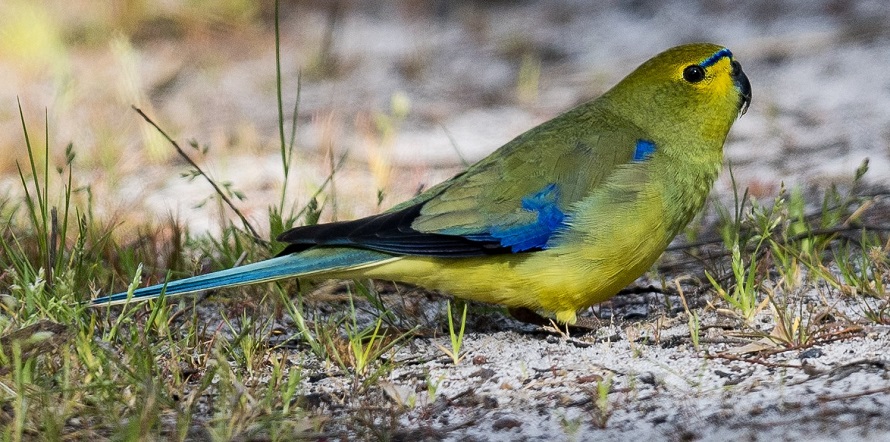
Photo: Blue-winged Parrot by Dennis Braddy
Leaders: Steve Bird, Gina Nichol & local guides
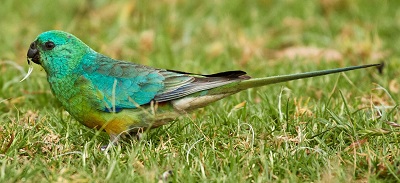 AUSTRALIA AUSTRALIASoutheast Specialties October 22 - November 1, 2026 Contact gina@sunrisebirding.com to reserve your space! Registration Form> TOUR PRICE: US$7695.00 provisional pricing per person, based on double occupancy and a minimum of 7 persons from Melbourne, Australia (airport code MEL). Single
supplement: US$995.00 provisional per person based on availability. Deposit: $1000.00
per person
per tour.
Note:
Tour deposits
can be
paid by
credit
card via
PayPal.
Use this link to
make your credit card payment. Please
advise gina@sunrisebirding.com
when you have made payment. Included in cost: All
accommodations,
meals during the tour,
and guide
services
as stated
in the
itinerary,
private
ground
transportation
during
the tour,
and park
entrance
fees. Not included: International, domestic flights, tipping for drivers and guides, travel insurance, excess baggage charges, private excursions, à la carte dishes, snacks, drinks, laundry, telephone calls and anything else of a purely personal nature. Also, any and all costs arising from pandemic or Covid-19 related issues are not included in the tour cost and are the sole responsibility of the traveler. These include, among others, the costs of Covid treatment, hospitalization, medical fees, transport, meals and accommodation in case of illness or quarantine, and the costs of any Covid tests needed before, during and after the tour.
Once
the tour is
confirmed to
go ahead, we
will send you
information
about booking
your flights.
**Please
note: Tour prices
are based on
quoted costs
from ground operators
(in their local
currency), estimated
fuel costs, and
the rate of exchange
the time of itinerary
publication.
The erratic nature
to global financial
markets makes
it difficult
to predict changes
in costs and
foreign currency
exchange rates
over the long
term. Since tours
are priced well
in advance of
the actual operation
of the tour,
tour costs, fuel
costs and exchange
rates can change,
sometimes drastically.
Depending on
the extent of
such changes,
it may be necessary
to implement
a surcharge on
this tour. If
a surcharge is
necessary, every
effort will be
made to minimize
the amount. Cancellations
and Refunds:
TRIP INSURANCE: PLEASE NOTE:
|
Phone: 203.453.6724